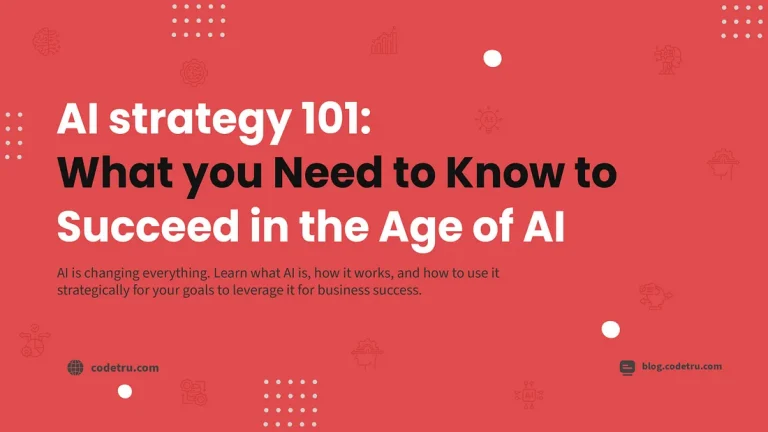In today’s dynamic business landscape, Artificial Intelligence (AI) stands as a transformative force, revolutionizing operations across various domain.
AI, in its essence, refers to machines exhibiting human-like intelligence through learning, reasoning, and problem-solving. Its applications span diverse domains, from healthcare and finance to manufacturing and customer service. The significance of AI for businesses lies in its potential to unlock unprecedented value and confer a competitive advantage.
AI is important for businesses because it can provide them with a competitive advantage in the rapidly changing and evolving market. AI can help businesses gain insights from large and complex data, automate and augment tasks and workflows, innovate and experiment with new solutions, and personalize and tailor offerings to different segments and preferences. According to a report by McKinsey, AI could add up to $13 trillion to the global economy by 2030. A survey by MIT Sloan Management Review and Boston Consulting Group found that 75% of executives believe AI will enable their companies to move into new businesses, and almost 85% believe AI will allow their companies to obtain or sustain a competitive advantage. A study by Accenture revealed that AI has the potential to boost profitability by an average of 38% across 16 industries, and increase employment by 10% by 2022.
Some examples of successful AI use cases and their benefits are:
Numerous success stories underscore AI’s potential. For instance, predictive analytics in supply chain management optimizes inventory, reducing costs and enhancing efficiency. AI-driven chatbots enhance customer service, boosting satisfaction and loyalty. Some giants in the industry like Netflix, Amazon and Spotify have used AI to provide their customers with an all-immersive experience
AI Strategy: What is it and how does it differ from a traditional IT strategy?
An AI strategy is a plan that defines how a business will leverage AI to achieve its vision, goals, and objectives, and how it will manage the opportunities and risks associated with AI. It is not the same as a traditional IT strategy, which focuses on the implementation and maintenance of IT systems and infrastructure and goes beyond the technical aspects of AI, and considers the strategic, organizational, cultural, ethical, and social implications of AI. It also requires a holistic and cross-functional approach, involving multiple stakeholders, such as business leaders, IT professionals, data scientists, domain experts, customers, partners, regulators, and society at large.
Key Components and Steps of an AI Strategy
An AI strategy consists of several components and steps, such as:
- Vision: Define the vision and purpose of AI for the business, and how it aligns with the overall strategy and values of the business. The vision should be clear, compelling, and inspiring, and should communicate the value proposition and differentiation of AI for the business.
- Goals: Set the specific, measurable, achievable, relevant, and time-bound (SMART) goals and objectives of AI for the business, and how they will be tracked and measured. The goals should be aligned with the vision, and should reflect the desired outcomes and impact of AI for the business.
- Data: Assess and improve the quality, availability, and accessibility of the data that is needed to train, test, and deploy AI solutions. Data is the fuel of AI, and without good data, AI cannot deliver good results. The data should be accurate, complete, consistent, relevant, and representative of the problem domain and the target population.
- Capabilities: Build or acquire the necessary AI capabilities, skills, and talent to design, develop, and deploy AI solutions. AI skills and talent include the people who have the knowledge, experience, and creativity to work with it, such as data scientists, engineers, developers, analysts, and managers.
- Governance: AI governance and ethics involve the policies, processes, standards, and principles that guide the development and deployment of AI solutions. It should also address the potential risks and challenges, such as bias, discrimination, privacy, security, safety, quality, compliance, and social responsibility, and should ensure the trust and confidence of your company’s stakeholders.
- Experimentation: Experimentation involves testing and validating the feasibility and viability of AI solutions, and learning from the feedback and results and should be done in an agile and iterative manner, using methods such as prototyping, piloting, and proof-of-concept.
Benefits and Challenges of Having an AI Strategy
Having an AI strategy can provide several benefits for a business, such as:
- Improved efficiency: AI can help a business improve its operational efficiency and productivity, by automating and augmenting tasks and workflows, optimizing resources and costs, and enhancing quality and accuracy.
- Increased innovation: AI can help a business increase its innovation and creativity, by enabling new products and services, new business models and processes, new customer segments and markets, and new sources of revenue and value.
- Enhanced customer satisfaction: AI can help a business enhance its customer satisfaction and loyalty, by providing personalized and tailored offerings, improving customer service and support, and creating engaging and interactive experiences.
- Reduced risk: AI can help a business reduce its risk and uncertainty, by providing insights and predictions, detecting and preventing anomalies and threats, and improving decision making and problem solving.
However, having an AI strategy also poses some challenges for a business, such as:
- Data Quality and Availability: Data is the key to AI, and without good data, AI cannot deliver good results. However, many businesses can face difficulties due to issues such as data inconsistency, data inaccuracy, data security, data privacy, and data compliance.
- AI Capabilities and Skills: It can be a challenge for many businesses, due lack of flexibility and adaptability in the existing employees
- AI Governance and Ethics: AI involves complex and sensitive issues, which require a high level of governance and ethics. However, it can be a challenge for many businesses, due to issues like lack of standards, guidelines, lack of awareness, lack of regulation, oversight, and enforcement.
How to create an AI strategy that works for your business?
Creating an AI strategy that works for your business requires a systematic and strategic approach, involving the following steps:
- Start with a clear vision and business case for AI and align it with your overall strategy. Identify the key drivers and motivations for adopting AI, and the key challenges and risks that you need to address and mitigate. Estimate the costs, benefits, and return on investment (ROI) of your AI initiatives.
- Identify and prioritize the most valuable and feasible AI use cases and opportunities for your business. Analyze your business processes, functions, and activities, and identify the areas where AI can add value and improve performance. Evaluate the potential impact, feasibility, and readiness of each AI use case, and prioritize the ones that are most aligned with your vision and goals, and that have the highest potential for value creation and competitive advantage.
- Data is the fuel of AI, and without good data, AI cannot deliver good results. Implement data quality management and data governance practices, such as data cleansing, validation, integration, standardization, and enrichment. Ensure data security and privacy, and comply with the relevant laws and regulations, such as the General Data Protection Regulation (GDPR).
- AI requires a high level of technical, analytical, and domain expertise, as well as a high level of creativity and innovation. Build or acquire the necessary AI capabilities, skills, and talent, and ensure they are aligned with your vision and goals. Train and upskill your existing workforce, and recruit and retain new talent, with the relevant AI knowledge and experience.
- Establish a robust AI governance and ethics framework, and monitor and measure the impact and outcomes of your AI initiatives. Assign roles and responsibilities, and establish oversight and accountability mechanisms, such as audits, reviews, and feedback loops. Monitor and measure the impact and outcomes, and ensure they are aligned with your vision and goals, and that they deliver value and benefit to your business and your stakeholders.
- Experiment, learn, and scale your AI solutions, and continuously update and refine your AI strategy. Experimentation involves testing and validating the feasibility and viability of your AI solutions, and learning from the feedback and results. It should be done in an agile and iterative manner, using methods such as prototyping, piloting, and proof-of-concept.
- Scaling involves expanding and extending your AI solutions to new domains, markets, and segments. It should also involve the integration and alignment of your AI solutions with the existing systems and processes of your business. Updating and refining your AI strategy and revisit your vision, goals, data, capabilities, governance, and ethics, based on the changing needs and expectations of your business.
Conclusion
In conclusion, AI is a powerful and transformative technology that can provide a competitive advantage and create value for businesses in various domains. However, AI also poses some challenges and risks that need to be addressed and mitigated. Therefore, having a well thought strategy is essential for businesses that want to leverage AI to achieve their vision, goals, and objectives, and to manage the opportunities and risks associated with AI.
Embrace the AI era by learning more about its applications and implications. Assess your current AI maturity, identify gaps, and seek expert guidance. The time is now to start your AI journey, ensuring your business is prepared for the transformative future of AI.
FAQs on AI Strategy: What You Need to Know
1. What is AI strategy and why is it important for businesses?
An AI strategy is a comprehensive plan that outlines how a business will use artificial intelligence to achieve its goals, increase productivity, and gain competitive advantage This is important because it helps businesses navigate AI implementation challenges , keep AI systems aligned with business objectives and efficient manage risks Helpful
2. How does an AI system differ from a traditional IT system?
Unlike traditional IT strategy that focuses on implementing and maintaining IT systems, AI strategy goes beyond the technical aspects. This includes a holistic approach that considers the strategic, organizational, cultural, ethical and social impact of AI, requiring the collaboration of various stakeholders
3. What are the key components of a successful AI system?
A successful AI strategy includes defining a clear vision, setting smart goals, ensuring high quality data, building or developing AI capabilities, establishing strong governance and ethical frameworks , and to encourage a culture of experimentation and continuous learning.
4. What are the key challenges in designing and implementing an AI system?
Key challenges include ensuring data quality and availability, acquiring the necessary AI skills and talent, maintaining AI governance and ethics, and integrating AI solutions into existing business processes. Addressing these challenges requires a strategic approach and ongoing change.
5. How can companies measure the success of their AI strategy?
Success can be measured by tracking the defined goals and objectives, and measuring the impact on operational efficiency, innovation, customer satisfaction and risk reduction. Regular monitoring, audits, and feedback loops are essential to ensure alignment with the business vision and to make necessary adjustments.







